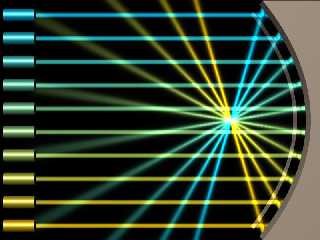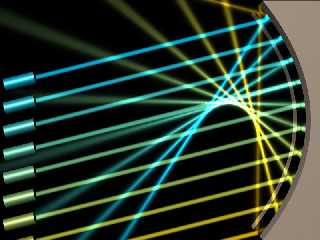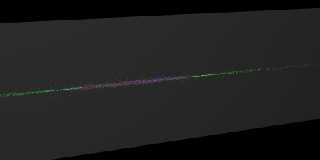 |
 |
|
 |
|
 |
|  |
|  |
|
 |
|
 |
|  |
|  |
|
 |
A smaller section of the parabola now.
This beautifully demonstrates *why* parabolic antennas have to be
perfectly aligned to work properly.
Post a reply to this message
Attachments:
Download 'ParabolicMirror3.jpg' (64 KB)
Download 'ParabolicMirror4.jpg' (68 KB)
Preview of image 'ParabolicMirror3.jpg'

Preview of image 'ParabolicMirror4.jpg'

|
 |
|  |
|  |
|
 |
|
 |
|  |
|  |
|
 |
very nice.
is anybody else seeing black dots
flashing at the beam crossings?
reminds me of the first time i used pov:
for testing methods for projecting a thin
line of light using a row or LED's and a
cylindrical lens.
jaap.
Post a reply to this message
Attachments:
Download 'leds.png' (18 KB)
Preview of image 'leds.png'

|
 |
|  |
|  |
|
 |
|
 |
|  |
|  |
|
 |
Jaap wrote:
> very nice.
>
> is anybody else seeing black dots
> flashing at the beam crossings?
Ooh, the image is just rife with optical illusions.
The two horizontal beams adjoining the focal point appear curved, and
the effect you just pointed out.
--
~Mike
Things! Billions of them!
Post a reply to this message
|
 |
|  |
|  |
|
 |
|
 |
|  |
|  |
|
 |
Warp <war### [at] tag povray povray org> wrote:
> A smaller section of the parabola now.
>
> This beautifully demonstrates *why* parabolic antennas have to be
> perfectly aligned to work properly.
....And why the mirrors in my Newtonian telescope must be perfectly aligned
to get a planet with crisp rings, rather than a yellow oval fuzzball.
What code did you use for the media? I've tried something similar in the
past without much success. org> wrote:
> A smaller section of the parabola now.
>
> This beautifully demonstrates *why* parabolic antennas have to be
> perfectly aligned to work properly.
....And why the mirrors in my Newtonian telescope must be perfectly aligned
to get a planet with crisp rings, rather than a yellow oval fuzzball.
What code did you use for the media? I've tried something similar in the
past without much success.
Post a reply to this message
|
 |
|  |
|  |
|
 |
|
 |
|  |
|  |
|
 |
Warp <war### [at] tag povray povray org> wrote:
> A smaller section of the parabola now.
>
> This beautifully demonstrates *why* parabolic antennas have to be
> perfectly aligned to work properly.
Excellently done! Could you post the source, please? Or at least the
settings? I've tried similar things, with very poor results.
Dave Matthews org> wrote:
> A smaller section of the parabola now.
>
> This beautifully demonstrates *why* parabolic antennas have to be
> perfectly aligned to work properly.
Excellently done! Could you post the source, please? Or at least the
settings? I've tried similar things, with very poor results.
Dave Matthews
Post a reply to this message
|
 |
|  |
|  |
|
 |
|
 |
|  |
|  |
|
 |
Dave Matthews <dma### [at] wr mnwest mnwest mnscu mnscu edu> wrote:
> Excellently done! Could you post the source, please? Or at least the
> settings? I've tried similar things, with very poor results.
camera { location -z*29 look_at 0 angle 20 }
plane { z, -30 pigment { rgb .6 } finish { ambient 1 } }
light_source
{ -z*29+y*10-x*10, 1 media_interaction off
photons { reflection off refraction off }
}
global_settings
{ photons
{ count 1000000
media 200
}
}
union
{ intersection
{ quadric { <0, -1, 0>, <0, 0, 0>, <-1, 0, 0>, 0 }
box { <-.4*.4, .4, -.1>, <.5, -.4, .1> }
bounded_by { box { <-.4*.4, .4, -.1>, <.5, -.4, .1> } }
pigment { rgb 0 }
photons { target reflection on collect off }
finish { reflection 1 ambient 0 diffuse 0 }
}
intersection
{ quadric { <0, -1, 0>, <0, 0, 0>, <-1, 0, 0>, 0 }
box { <-.4*.4, .4, -.2>, <.5, -.4, .2> }
bounded_by { box { <-.4*.4, .4, -.2>, <.5, -.4, .2> } }
pigment { rgb <1,.9,.8> }
photons { target collect off }
translate x*.001
}
scale 9
translate x*4.5
}
box
{ <-9, -4, -.11>, <5, 4, .11> hollow
pigment { rgbt 1 }
photons { pass_through }
interior { media { scattering { 1, 1 extinction .001 } } }
}
#include "transforms.inc"
#macro Light(YOffset, PointAtYOffset, Color)
light_source
{ <-4, YOffset, 0>, Color*5
cylinder radius .05 falloff .1 point_at y*(YOffset+PointAtYOffset)
parallel point_at y*(YOffset+PointAtYOffset)
}
cylinder
{ -x*.01, -x, .2
pigment { rgb Color }
finish { specular .5 }
#if(PointAtYOffset != 0)
Reorient_Trans(-x, -x*4-y*PointAtYOffset)
#end
translate <-4, YOffset, 0>
}
#end
#declare YInd = 3.375;
#declare ColorInd = 0;
#while(YInd >= -3.4)
Light(YInd, 0, <ColorInd, .8, 1-ColorInd>)
#declare YInd = YInd-.75;
#declare ColorInd = ColorInd+1/9;
#end edu> wrote:
> Excellently done! Could you post the source, please? Or at least the
> settings? I've tried similar things, with very poor results.
camera { location -z*29 look_at 0 angle 20 }
plane { z, -30 pigment { rgb .6 } finish { ambient 1 } }
light_source
{ -z*29+y*10-x*10, 1 media_interaction off
photons { reflection off refraction off }
}
global_settings
{ photons
{ count 1000000
media 200
}
}
union
{ intersection
{ quadric { <0, -1, 0>, <0, 0, 0>, <-1, 0, 0>, 0 }
box { <-.4*.4, .4, -.1>, <.5, -.4, .1> }
bounded_by { box { <-.4*.4, .4, -.1>, <.5, -.4, .1> } }
pigment { rgb 0 }
photons { target reflection on collect off }
finish { reflection 1 ambient 0 diffuse 0 }
}
intersection
{ quadric { <0, -1, 0>, <0, 0, 0>, <-1, 0, 0>, 0 }
box { <-.4*.4, .4, -.2>, <.5, -.4, .2> }
bounded_by { box { <-.4*.4, .4, -.2>, <.5, -.4, .2> } }
pigment { rgb <1,.9,.8> }
photons { target collect off }
translate x*.001
}
scale 9
translate x*4.5
}
box
{ <-9, -4, -.11>, <5, 4, .11> hollow
pigment { rgbt 1 }
photons { pass_through }
interior { media { scattering { 1, 1 extinction .001 } } }
}
#include "transforms.inc"
#macro Light(YOffset, PointAtYOffset, Color)
light_source
{ <-4, YOffset, 0>, Color*5
cylinder radius .05 falloff .1 point_at y*(YOffset+PointAtYOffset)
parallel point_at y*(YOffset+PointAtYOffset)
}
cylinder
{ -x*.01, -x, .2
pigment { rgb Color }
finish { specular .5 }
#if(PointAtYOffset != 0)
Reorient_Trans(-x, -x*4-y*PointAtYOffset)
#end
translate <-4, YOffset, 0>
}
#end
#declare YInd = 3.375;
#declare ColorInd = 0;
#while(YInd >= -3.4)
Light(YInd, 0, <ColorInd, .8, 1-ColorInd>)
#declare YInd = YInd-.75;
#declare ColorInd = ColorInd+1/9;
#end
Post a reply to this message
|
 |
|  |
|  |
|
 |
|
 |
|  |
|  |
|
 |
Ricky,
Ever try to build a POV virtual Newtonian telescope and image a distant
object through an eyepiece? I've had good success with the scope and
(Primary & Secondary) mirrors but haven't tried to build an eyepiece "lens"
system yet.
"Cousin Ricky" <ric### [at] yahoo com> wrote in message
news:web.42893a00408416d1755fa2580@news.povray.org...
> Warp <war### [at] tag com> wrote in message
news:web.42893a00408416d1755fa2580@news.povray.org...
> Warp <war### [at] tag povray povray org> wrote:
>> A smaller section of the parabola now.
>>
>> This beautifully demonstrates *why* parabolic antennas have to be
>> perfectly aligned to work properly.
>
> ....And why the mirrors in my Newtonian telescope must be perfectly
> aligned
> to get a planet with crisp rings, rather than a yellow oval fuzzball.
>
> What code did you use for the media? I've tried something similar in the
> past without much success.
> org> wrote:
>> A smaller section of the parabola now.
>>
>> This beautifully demonstrates *why* parabolic antennas have to be
>> perfectly aligned to work properly.
>
> ....And why the mirrors in my Newtonian telescope must be perfectly
> aligned
> to get a planet with crisp rings, rather than a yellow oval fuzzball.
>
> What code did you use for the media? I've tried something similar in the
> past without much success.
>
Post a reply to this message
|
 |
|  |
|  |
|
 |
|
 |
|  |
|  |
|
 |
Warp,
Thanks a bunch for posting the source code for this. It's really elegant.
How long does it take to render this on your machine?
"Warp" <war### [at] tag povray povray org> wrote in message
news:428a5544@news.povray.org...
> Dave Matthews <dma### [at] wr org> wrote in message
news:428a5544@news.povray.org...
> Dave Matthews <dma### [at] wr mnwest mnwest mnscu mnscu edu> wrote:
>> Excellently done! Could you post the source, please? Or at least the
>> settings? I've tried similar things, with very poor results.
>
> camera { location -z*29 look_at 0 angle 20 }
> plane { z, -30 pigment { rgb .6 } finish { ambient 1 } }
> light_source
> { -z*29+y*10-x*10, 1 media_interaction off
> photons { reflection off refraction off }
> }
>
> global_settings
> { photons
> { count 1000000
> media 200
> }
> }
>
> union
> { intersection
> { quadric { <0, -1, 0>, <0, 0, 0>, <-1, 0, 0>, 0 }
> box { <-.4*.4, .4, -.1>, <.5, -.4, .1> }
> bounded_by { box { <-.4*.4, .4, -.1>, <.5, -.4, .1> } }
> pigment { rgb 0 }
> photons { target reflection on collect off }
> finish { reflection 1 ambient 0 diffuse 0 }
> }
> intersection
> { quadric { <0, -1, 0>, <0, 0, 0>, <-1, 0, 0>, 0 }
> box { <-.4*.4, .4, -.2>, <.5, -.4, .2> }
> bounded_by { box { <-.4*.4, .4, -.2>, <.5, -.4, .2> } }
> pigment { rgb <1,.9,.8> }
> photons { target collect off }
> translate x*.001
> }
> scale 9
> translate x*4.5
> }
>
> box
> { <-9, -4, -.11>, <5, 4, .11> hollow
> pigment { rgbt 1 }
> photons { pass_through }
> interior { media { scattering { 1, 1 extinction .001 } } }
> }
>
> #include "transforms.inc"
>
> #macro Light(YOffset, PointAtYOffset, Color)
> light_source
> { <-4, YOffset, 0>, Color*5
> cylinder radius .05 falloff .1 point_at y*(YOffset+PointAtYOffset)
> parallel point_at y*(YOffset+PointAtYOffset)
> }
> cylinder
> { -x*.01, -x, .2
> pigment { rgb Color }
> finish { specular .5 }
> #if(PointAtYOffset != 0)
> Reorient_Trans(-x, -x*4-y*PointAtYOffset)
> #end
> translate <-4, YOffset, 0>
> }
> #end
>
> #declare YInd = 3.375;
> #declare ColorInd = 0;
> #while(YInd >= -3.4)
> Light(YInd, 0, <ColorInd, .8, 1-ColorInd>)
> #declare YInd = YInd-.75;
> #declare ColorInd = ColorInd+1/9;
> #end edu> wrote:
>> Excellently done! Could you post the source, please? Or at least the
>> settings? I've tried similar things, with very poor results.
>
> camera { location -z*29 look_at 0 angle 20 }
> plane { z, -30 pigment { rgb .6 } finish { ambient 1 } }
> light_source
> { -z*29+y*10-x*10, 1 media_interaction off
> photons { reflection off refraction off }
> }
>
> global_settings
> { photons
> { count 1000000
> media 200
> }
> }
>
> union
> { intersection
> { quadric { <0, -1, 0>, <0, 0, 0>, <-1, 0, 0>, 0 }
> box { <-.4*.4, .4, -.1>, <.5, -.4, .1> }
> bounded_by { box { <-.4*.4, .4, -.1>, <.5, -.4, .1> } }
> pigment { rgb 0 }
> photons { target reflection on collect off }
> finish { reflection 1 ambient 0 diffuse 0 }
> }
> intersection
> { quadric { <0, -1, 0>, <0, 0, 0>, <-1, 0, 0>, 0 }
> box { <-.4*.4, .4, -.2>, <.5, -.4, .2> }
> bounded_by { box { <-.4*.4, .4, -.2>, <.5, -.4, .2> } }
> pigment { rgb <1,.9,.8> }
> photons { target collect off }
> translate x*.001
> }
> scale 9
> translate x*4.5
> }
>
> box
> { <-9, -4, -.11>, <5, 4, .11> hollow
> pigment { rgbt 1 }
> photons { pass_through }
> interior { media { scattering { 1, 1 extinction .001 } } }
> }
>
> #include "transforms.inc"
>
> #macro Light(YOffset, PointAtYOffset, Color)
> light_source
> { <-4, YOffset, 0>, Color*5
> cylinder radius .05 falloff .1 point_at y*(YOffset+PointAtYOffset)
> parallel point_at y*(YOffset+PointAtYOffset)
> }
> cylinder
> { -x*.01, -x, .2
> pigment { rgb Color }
> finish { specular .5 }
> #if(PointAtYOffset != 0)
> Reorient_Trans(-x, -x*4-y*PointAtYOffset)
> #end
> translate <-4, YOffset, 0>
> }
> #end
>
> #declare YInd = 3.375;
> #declare ColorInd = 0;
> #while(YInd >= -3.4)
> Light(YInd, 0, <ColorInd, .8, 1-ColorInd>)
> #declare YInd = YInd-.75;
> #declare ColorInd = ColorInd+1/9;
> #end
Post a reply to this message
|
 |
|  |
|  |
|
 |
|
 |
|  |
|  |
|
 |
"Catseye" <jpf### [at] comcast net> wrote:
> Ricky,
>
> Ever try to build a POV virtual Newtonian telescope and image a distant
> object through an eyepiece? I've had good success with the scope and
> (Primary & Secondary) mirrors but haven't tried to build an eyepiece "lens"
> system yet.
I've done the parabolic primary with good results. It was just a quick
proof-of-concept thing, so i didn't bother with the secondary or eyepiece.
Parabolic reflection is straightforward, but designing a multiple lens
system requires, um, library books and math. The secondary would also have
been straightforward, but i didn't see the point without an eyepiece.
Warp's project interested me, because i had once tried to trace the path of
a ray of light through a brilliant round cut diamond. net> wrote:
> Ricky,
>
> Ever try to build a POV virtual Newtonian telescope and image a distant
> object through an eyepiece? I've had good success with the scope and
> (Primary & Secondary) mirrors but haven't tried to build an eyepiece "lens"
> system yet.
I've done the parabolic primary with good results. It was just a quick
proof-of-concept thing, so i didn't bother with the secondary or eyepiece.
Parabolic reflection is straightforward, but designing a multiple lens
system requires, um, library books and math. The secondary would also have
been straightforward, but i didn't see the point without an eyepiece.
Warp's project interested me, because i had once tried to trace the path of
a ray of light through a brilliant round cut diamond.
Post a reply to this message
|
 |
|  |
|  |
|
 |
|
 |
|  |
|
 |




![]()